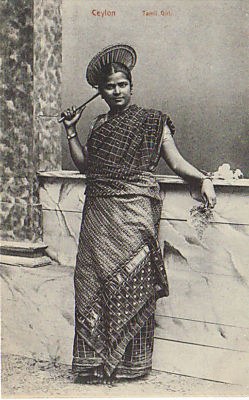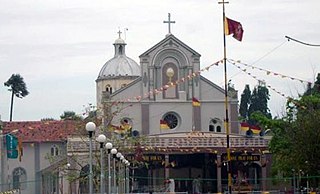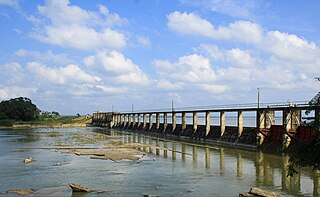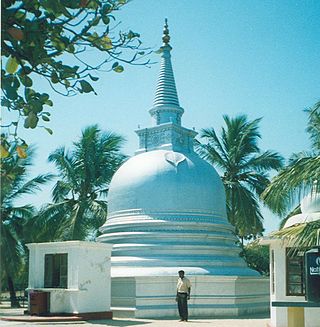
The history of Sri Lanka is one of richness in history with a uniqueness that extends its relevance beyond the areas of South Asia, Southeast Asia and the Indian Ocean. The early human remains found on the island of Sri Lanka date to about 38,000 years ago.

Sri Lankan Tamils, also known as Ceylon Tamils or Eelam Tamils, are Tamils native to the South Asian island state of Sri Lanka. Today, they constitute a majority in the Northern Province, form the plurality in the Eastern Province and are in the minority throughout the rest of the country. 70% of Sri Lankan Tamils in Sri Lanka live in the Northern and Eastern provinces.
Ketheeswaram temple is an ancient Hindu temple in Mannar, Northern Province, Sri Lanka. It is the oldest temple in Sri Lanka with at least 1400 years of evidence. Overlooking the ancient Tamil port towns of Manthai and Kudiramalai, the temple has lain in ruins, been restored, renovated and enlarged by various royals and devotees throughout its history. Thirukketheeswaram is one of the Pancha Ishwarams dedicated to the Hindu deity Shiva and is venerated by Shaivas throughout the continent. Throughout its history, the temple has been administered and frequented by Sri Lankan Hindu Tamils. Its famous tank, the Palavi tank, is of ancient antiquity and was restored from the ruins. Thirukketheeswaram is one of the 275 Paadal Petra Sthalams of Shiva glorified in the poems of the Tevaram.

The Diocese of Jaffna is a Latin Church ecclesiastical territory or diocese of the Catholic Church in northern Sri Lanka. Latin Catholicism in the diocese's territory date to the time of St. Francis Xavier. The current bishop is Justin Gnanapragasam.

The Vankalai massacre was a massacre of a family of four minority Sri Lankan Tamils at the hands of the Sri Lankan military personnel from the village of Vankalai in Mannar District, Sri Lanka on June 8, 2006. The victims were tortured and the mother was gang raped before her murder.

Mary Bastian was a Sri Lankan Tamil human rights activist and Catholic priest. He was shot and killed along with 10 other civilians on January 6, 1985, during the Sri Lankan Civil War, allegedly by the Sri Lankan Army.
The Anuradhapura massacre occurred in Sri Lanka in 1985 and was carried out by the Liberation Tigers of Tamil Eelam. This was the largest massacre of Sinhalese civilians by the LTTE to date; it was also the first major operation carried out by the LTTE outside a Tamil majority area. Initially, EROS claimed responsibility for the massacre, but it later retracted the statement, and joined the PLOTE in denouncing the incident. The groups later accused the LTTE for the attack. Since then, no Tamil militant group has admitted to committing the massacre. However, state intelligence discovered that the operation was ordered by the LTTE's leader Velupillai Prabhakaran. He assigned the massacre to the LTTE Mannar commander Victor and it was executed by Victor's subordinate Anthony Kaththiar. The LTTE carried out the attack as a retaliation for the 1985 Valvettiturai massacre, where the Sri Lanka Army massacred 70 Tamil civilians in Prabhakaran's hometown.

Mullaitivu District is one of the 25 districts of Sri Lanka, the second level administrative division of the country. The district is administered by a District Secretariat headed by a District Secretary appointed by the central government of Sri Lanka. The capital of the district is the town of Mullaitivu.
The Northern Theater of Eelam War IV refers to the fighting that took place in the northern province of Sri Lanka between July 2006 and May 18, 2009.
The Diocese of Mannar is a Roman Catholic diocese for north-western Sri Lanka, administered by the Bishop of Mannar, currently Fidelis Fernando.

Mannar is the main town of Mannar District, Northern Province, Sri Lanka. It is governed by an Urban Council. The town is located on Mannar Island overlooking the Gulf of Mannar and is home to the historic Ketheeswaram temple. In the Tamil language, Mannar means the raised place [of sand] which is though to have come from the geology of Mannar Island which was formed by the accumulation of sand.

Right Reverend Emmanuel Thomas Savundaranayagam is a Sri Lankan Tamil priest and former Roman Catholic Bishop of Jaffna.

Madhu church shelling or Madhu church massacre is the name for the shelling of the Shrine of Our Lady of Madhu in Sri Lanka during the Sri Lankan civil war on November 20, 1999. The shelling resulted in the deaths of approximately 40 minority Sri Lankan Tamil civilians, including children, and more than 60 non-fatal injuries. The exact cause and nature of the event is disputed between the rebel Liberation Tigers of Tamil Eelam and the Sri Lankan government. According to Bishop Rayappu Joseph, the attack was carried out by the LTTE. The church is a Roman Catholic Marian shrine in Mannar district of Sri Lanka. With a history of over 400 years, this shrine acts as a center for pilgrimage and worship for Sri Lankan Catholics and others. The site is considered as the holiest Catholic shrine in the island.

Mannar District is one of the 25 districts of Sri Lanka, the second level administrative division of the country. The district is administered by a District Secretariat headed by a District Secretary appointed by the central government of Sri Lanka. The capital of the district is Mannar, which is located on Mannar Island.

Mariampillai Thaddeus Sarathjeevan was a Catholic priest from Jaffna, Sri Lanka. He was one of the few priests who remained with the refugees until the end of war in northern parts of Sri Lanka. He died while he was leading the last batch of refugees to safety from war zone.

Nagadeepa Purana Vihara is an ancient Buddhist temple situated in Jaffna district of Northern Province, Sri Lanka. It is among the country's sixteen holiest Buddhist shrines (Solosmasthana). According to contemporary history, the Gautama Buddha visited the site after five years of attaining Enlightenment to settle the dispute between two warring Naga kings, Chulodara and Mahodara.
Bishop Rayappu Joseph was a Sri Lanka Tamil prelate and the Roman Catholic Bishop of Mannar.

The statue of Our Lady of Miracles, Jaffna patão is a wooden statue, now preserved in the church of São Pedro, in Bainguinim, Goa, India.
Madhu Road railway station is a railway station in the town of Madhu in northern Sri Lanka. The station serves pilgrims visiting the Shrine of Our Lady of Madhu. Owned by Sri Lanka Railways, the state-owned railway operator, the station is part of the Mannar Line which links Mannar Island with the capital Colombo. The station was not functioning between 1990 and 2013 due to the civil war. The Mannar Line between Medawachchiya and Madhu Road was re-opened on 14 May 2013.
















